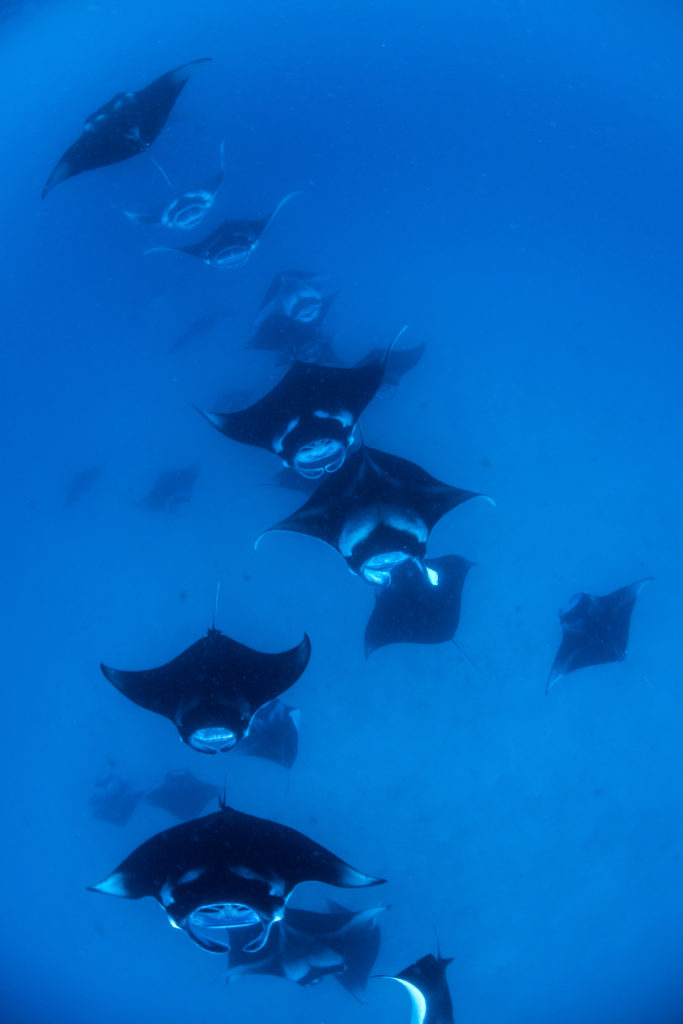Originally an independent organization founded to research manta rays in Indonesia, Marine Megafauna SE Asia is running several conservation and education programs in and around Indonesia. They have a strong focus on manta-ray protection. Today we’re chatting with Helen Mitchell, one of the founders of Marine Megafauna Foundation SE Asia.
What do you do?
“Our primary focus is always conservation,” says Mitchell. “So now that we have helped get manta rays nationwide protection in Indonesia, we are keen to pioneer, participate and help with any other issues that affect the marine environment, and especially these gentle giants.”
How and why did it all start?
Peter Bassett and Helen Mitchell started the project on Nusa Lembongan, Bali, as Aquatic Alliance. Mitchell explains, “We had an intense period of training with Dr. Andrea Marshall and Dr. Simon Pierce at the Marine Megafauna Foundation in Mozambique.”
Bassett and Mitchell are not scientists, and became involved in conservation after switching careers. Drs. Marshall and Pierce trained the two budding conservationists on research methods to identify mantas, how to take ID shots and use databases, and how to evaluate conservation efforts in the area.
“We had dived with the mantas of Bali before and loved it here,” said Mitchell. “So when we were offered support from one of the local dive shops on Nusa Lembongan to come and take a closer look, we jumped at the chance.
Big Fish offered us some work space and the use of their facilities to run free lectures. They also offer logistical support to dive the manta sites. Soon a lot of other Nusa Lembongan shops took us diving for free to help our research so we could go and ID manta rays.”
After a few years of conservation work around Nusa Lembongan, Bassett and Mitchell joined Marine Megafauna Foundation to work under the same name. PhD researcher Elitza Germanov joined the project as well. Germanov was already building a database of manta rays in Komodo National Park, and started her research there. Germanov is studying the potential ingestion of plastic debris by large filter-feeding fish. She studies manta and mobula rays, as well as whale sharks.
Her research focuses on the smallest plastic debris, or microplastics. The primary research sites are in Nusa Penida and Komodo National Park. She also collaborates with researchers in the Philippines and Tanzania.
What are the MMF Southeast Asia’s main areas of focus?
“Within the Nusa Penida marine park, the team keeps baseline data on marine megafauna, the health of the coral, and how many boats are at the dive sites every day,” says Mitchell.
“We also have several educational programs of varying sorts, such as weekly lectures for tourists and divers, coloring books distributed to local schools/communities and Code of Conduct training sessions for the local dive industry.”
Thanks to these efforts, most of the area’s dive professionals have received training on proper manta-ray interaction and the local ecosystem’s importance to the manta rays. Several dive shops on Nusa Lembongan offer dives to Manta Point and Manta Bay. They routinely give away their free spots on the boat to members of Marine Megafauna. This way they can dive, take pictures of the mantas for ID, and collect samples that could be valuable to Germanov’s research. When on the dive boats, MMF members can also discuss conservation and manta-ray behavior with other divers.
Where does MMF SE Asia operate?
In addition to Nusa Penida and Komodo, MMF SE Asia is expanding its efforts to Raja Ampat, Indonesia. Two PhD students, Stephanie Venables and Rob Perryman, have recently begun projects there in partnership with Papua Explorers Dive Resort. Venables is also focusing on manta-ray population genetics. She is developing genetic techniques to be used as conservation tools for global species and population assessments.
Perryman is looking into the social structure and behavior of reef-manta populations. He’s using social-network analysis to answer new and unique questions about sociality within populations. The Raja Ampat project will continue to collect data for ongoing photo ID studies, adding to regional and national catalogues. Most importantly, researchers are working with local communities and tourism stakeholders to promote sustainable and minimal-impact manta ray tourism in the area.
How can people help?
Become a “citizen scientist” by uploading your manta-ray ID shots to the first worldwide manta-ray database. Begun by Dr. Marshall, it’s the only forum open to all manta-ray scientists for sharing and comparing sightings. You can also help fund research and continued protection of these ocean giants with a contribution here.
Volunteer positions open regularly. If you would like to spend some time on Nusa Lembongan, helping with manta research, get in touch with the team.


